Varanasi
The most chaotic part of our overnight train from Kolkata to Mughal Sarai was the taxi ride to Howrah Station at 8 at night. The shear volume and variety of traffic en route boggles the mind.
We had class 2AC tickets, basically 2nd class, air-conditioned—but it was effectively 1st class, as no 1AC trains depart from Kolkata. The train car was relatively wide and spacious. The AC was pleasantly copious. In addition, each compartment had a fan. Stephanie felt fine. Phew.
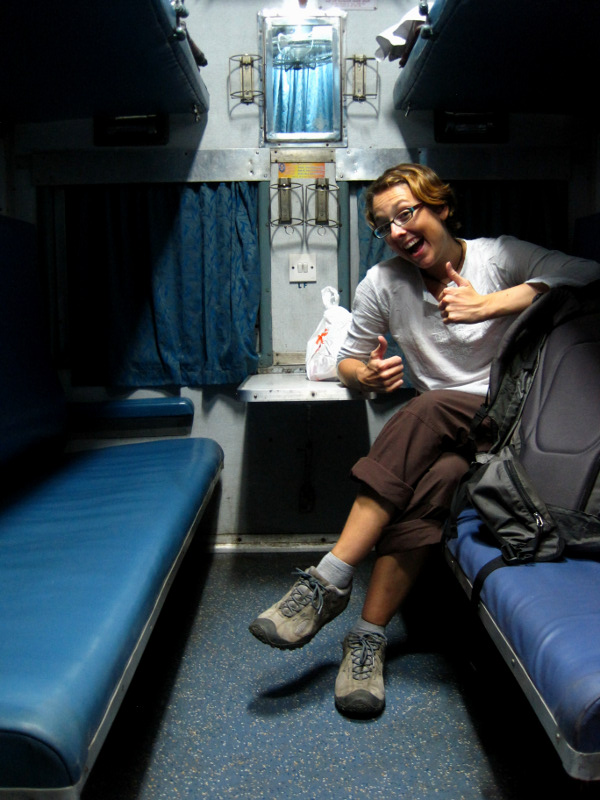
After a while there were six people sitting in our compartment with 4 beds: a newlywed couple with their mother, an older man who didn’t say a word, and the two of us. The couple, two doctors from Kolkata, started the usual interrogation, but added some more pointed questions about how much this months-long travel was costing us and what exactly was the benefit—how would it affect us professionally? I’m not sure our answers were satisfying—it’s been a long time since we had to justify what has seemed self-evident to everyone we meet—but we tried. As the train started to pull out of the station, the husband stopped whatever he was saying mid-sentence, bid us goodbye, and the couple rushed off the train. Now the sleeping arrangements made sense. Stephanie and I took the top bunks so the mother and the old man could sleep on the bottom.
I drifted in and out of sleep, waking ahead of my 7:30am alarm. We were due to arrive in Mughal Sarai at 8:10. The train would continue after that and I did not want to miss our stop. There was no conductor announcing stations nor checking to make sure we got off at the right place.
Though in some ways were were escaping Kolkata for Varanasi, we’d heard similarly sordid stories about our new destination. We had contemplated skipping it altogether—Stephanie was eager to get to Rajasthan before it got too hot—but it was one of those cities that seems to factor highly in people’s must-see lists of India (even if only for a day or two). I was curious. Plus it was on the way.
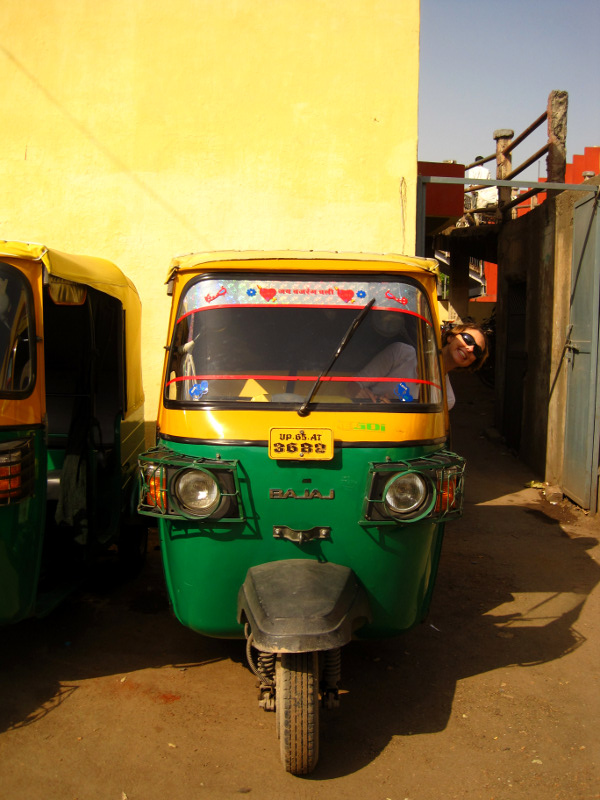
We arrived in Mughal Sarai and got a rickshaw to take us the 12km to Varanasi, near the Assi Ghat. The rickshaw driver took us to a hotel he “recommended” (rickshaw drivers often get commissions from hotels, so they try to steer tourists towards the highest commission). It wasn’t bad—actually it was a vast improvement over our digs in Kolkata. On principle, we compared it to another we’d underlined in the Lonely Planet, but ended up returning to the first.
Varanasi sits on the banks of the mighty Ganges (known locally as Mother Ganga), the most sacred river in India. It was the end of the dry season, so the water level was quite low. The ghats, or steps, are built along the banks of the river, creating a space where people come together to pray, bathe, do laundry, worship, cremate their loved ones, pee, play cricket, swim, dry clothes, and I’m sure much more. Each ghat has a name, and is usually associated with a temple or some organization at the top of the steps. On our first evening we took a stroll up a few ghats (there are over 90) and sat on the steps watching the people and the river go by while the sun set.
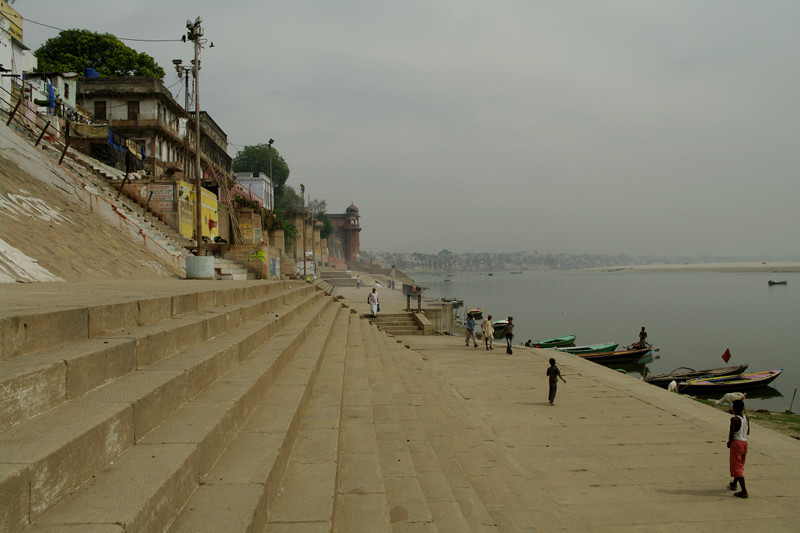
The next morning we walked further up the ghats. I particularly enjoyed the boats moored along the water’s edge. When we reached the first crematorium ghat we were intercepted by a man and given a long and articulate explanation of the proceedings. Of course it ended with a request for money, to help pay for the (500 rupee/kilo!?) wood for families that cannot afford it themselves. It also ended with us watching a family set one of the funeral pyres alight, in full view at the river’s edge—the body wrapped in white cloth and clearly visible between the logs. Stephanie started to cry, so I gave the man 300 rupees (about $7), and we continued walking. Not sure if he was for real, but the story was excellent.
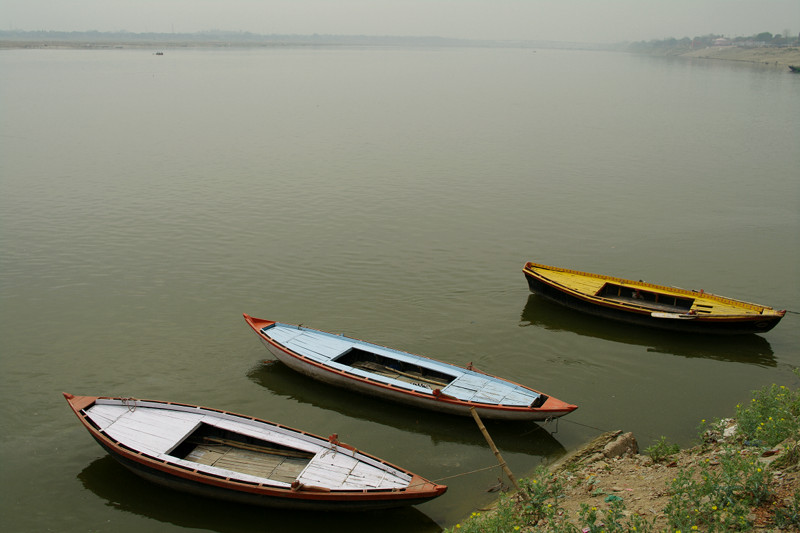
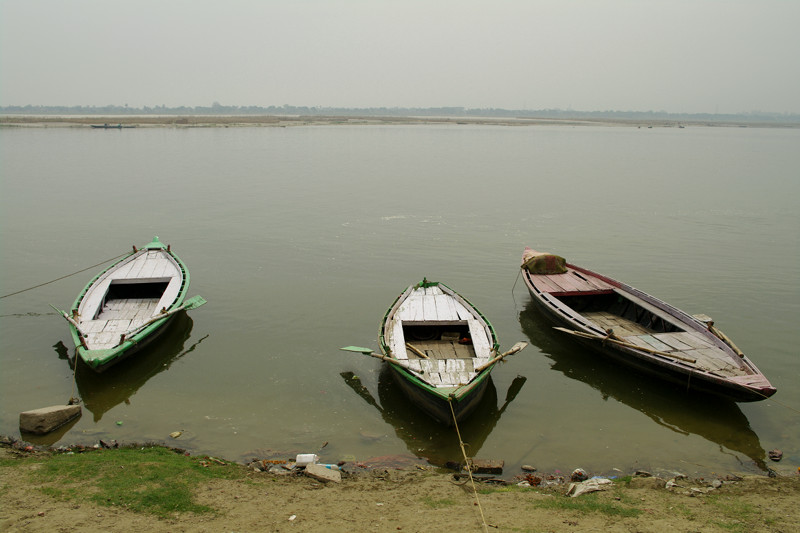
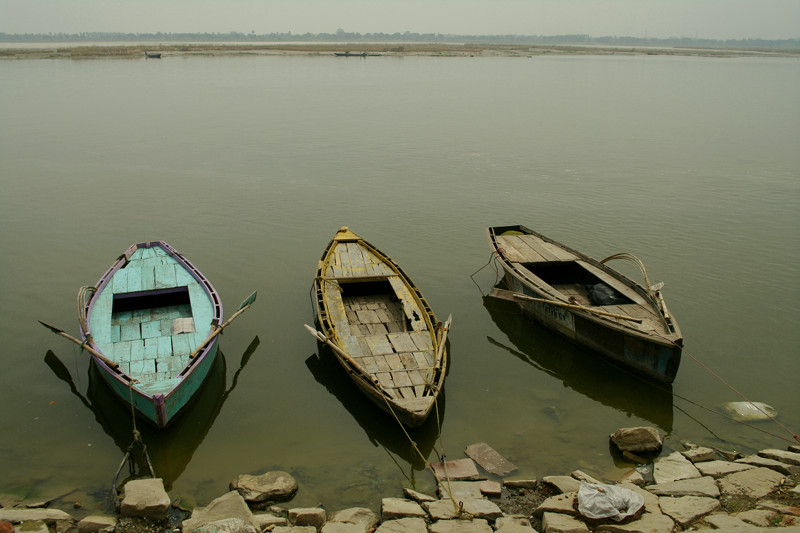
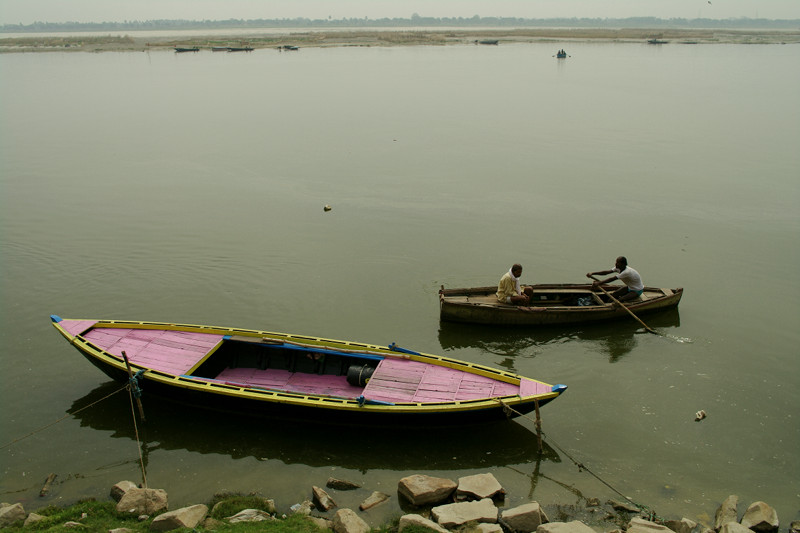
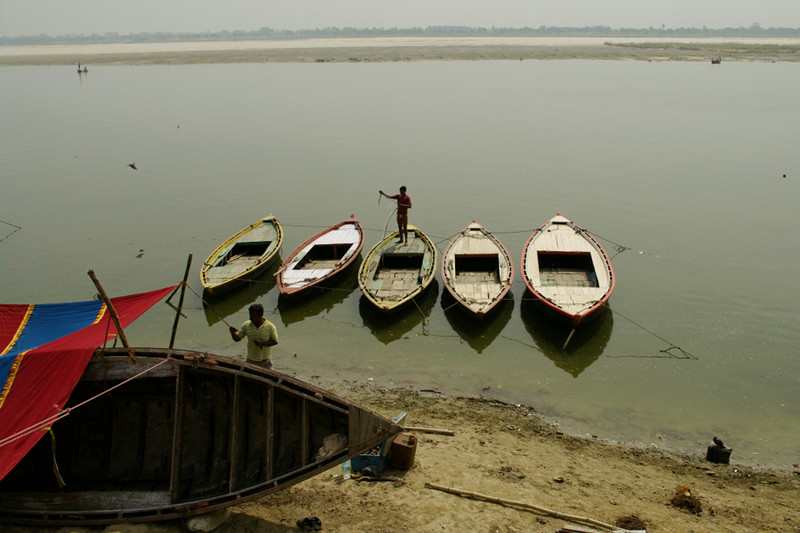
On our third day we woke up before 5am to take a boat on the Ganges. We went as far as the second, larger crematorium ghat as the sun was rising. There we were met by a Brahmin priest who delivered exactly the same cremation story. We listened attentively and parted with another 400 rupees on behalf of our karma.
Part of the story involves the list of people who do not need to be cremated because they are already “pure”. It includes children under the age of 16, pregnant women, people with leprosy, people with small pox, etc. In these special cases, the body is tied down with rocks, taken in a boat to the middle of the river, and dropped overboard. That knowledge didn’t make it any easier when, on our way back to Assi Ghat, we came upon a dead body in the river, face down, having apparently come free from its rocks. It was floating not far from shore, not far from where people were bathing and doing their laundry. It was a surreal sight.
The sun cast a rich morning light on the ghats as we continued on our way. I put the new telephoto zoom lens on the camera and gave it to Stephanie to play with. She took some wonderful shots of people’s colorful morning routine on the ghats: washing, swimming, and laundering in the Ganges.
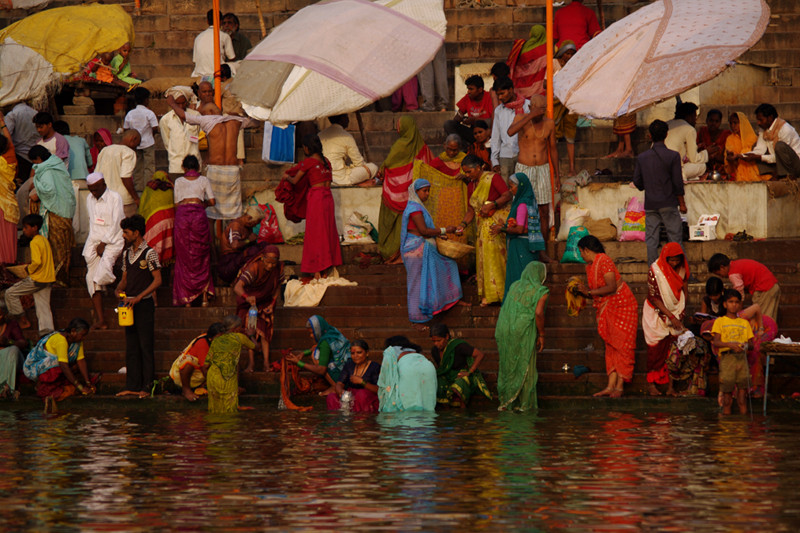
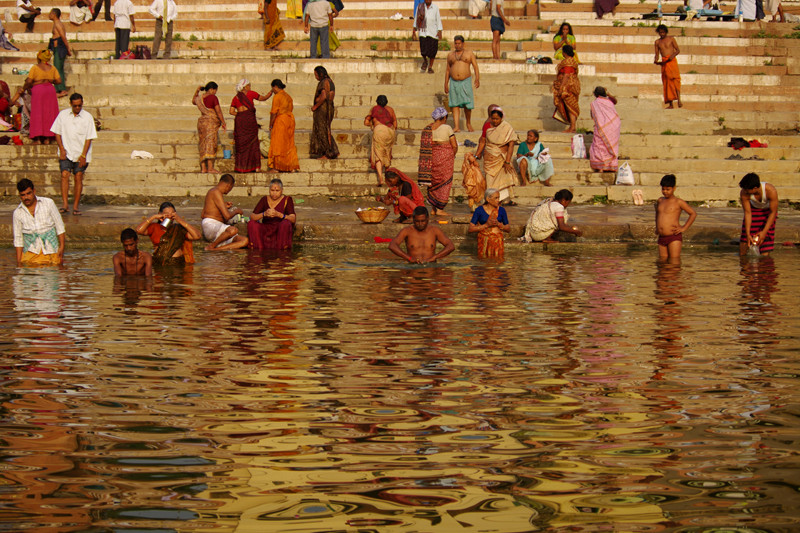

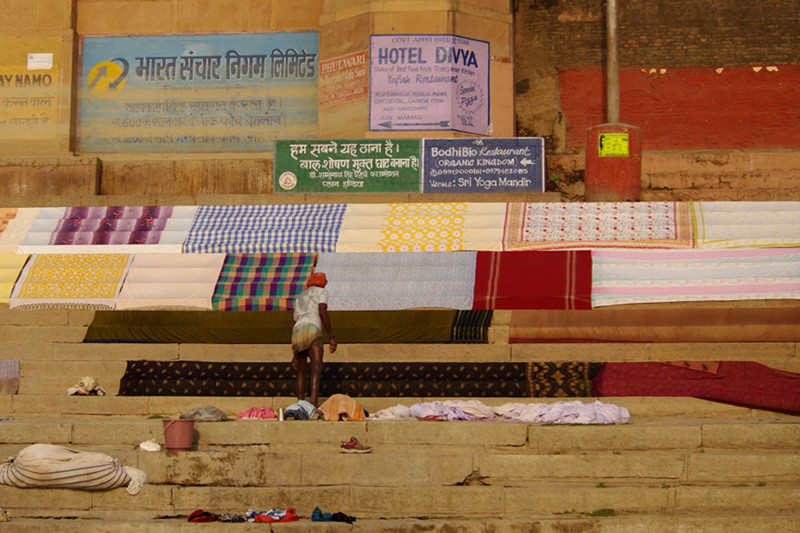
What a fantastic update, thank you! It must seem strange being half the way around the world and tossing these messages out. I’m reading every one and enjoying it immensely.
Actually, I thought of you a couple of days ago: I went to Las Vegas and had a fabulous crazy dinner at Guy Savoy. Excellent, but in some sense the opposite of the experiences you are having.
Nelson, so glad you’re enjoying. I admit it’s nice to know someone’s reading these dispatches from the field.
India is really something else. I was completely serious in my last post when I said that all our previous travel experiences on this trip, combined, were a necessary preparation for India. But it’s utter otherworldliness is what makes it so strangely enjoyable.
I love Southeast Asia, but it felt like a vacation. India feels like a journey.
I think your journey metaphor is correct. Chloe went to India when she was 14 to leave her aunt’s ashes in the Ganges. She came back different. I can’t put my finger on the change precisely, but as her mother, it really seemed like she had lost an illusion (in a good way) about her place in the world. Simultaneous with that loss, came an acute awareness of the richness (of color, of noise, of general differentness) she was experiencing.
Thanks so much for these updates.
There isn’t anything really to say about this part of your trip other than I can see how the experience would change someone’s view of the world. You have both seen such richness, such sadness, such beauty and such poverty all in one place–in one moment. I hold you both in my heart. Love, Mom
One impression (of many) this trip has left on me, in particular India, was challenging a thought I once held that a blog post, or a few photos, or a National Geographic article, or even a Discovery Channel documentary could go a long way towards capturing a far away place, could give a somewhat accurate impression of what it is like there, what it is like to be there, even if only a facet, a particular slice in time. It was one of the reasons I blog.
I’ve come to realize that there is something about immersing my whole self in a place, especially one as storied at the Ganges, that just can’t be replicated second hand. This is all the more profound in India: the smells, the noise, the heat, the smoke, the people, and your vision of the world turning in front of you, in real time, in three dimensions—everything seems turned up to the max, yet in many ways reality is less impressive than the stories (the myth). People can’t help but highlight the pretty, even when it’s grisly. I stood on the ghats, looking at the Ganges, and thought to myself “It’s a river.”
I’ve decided to content myself with the knowledge that these dispatches are but a shade of a real thing, that I too highlight the pretty, that “the real” is reserved for people who go there, but that what makes these posts interesting, at least to myself and the people who know me, is my circuitous interaction with the place.